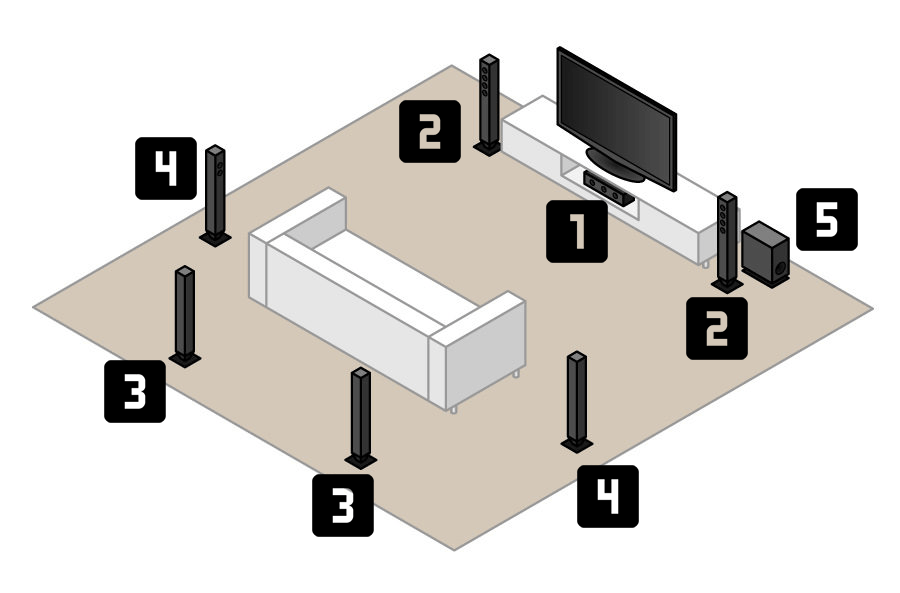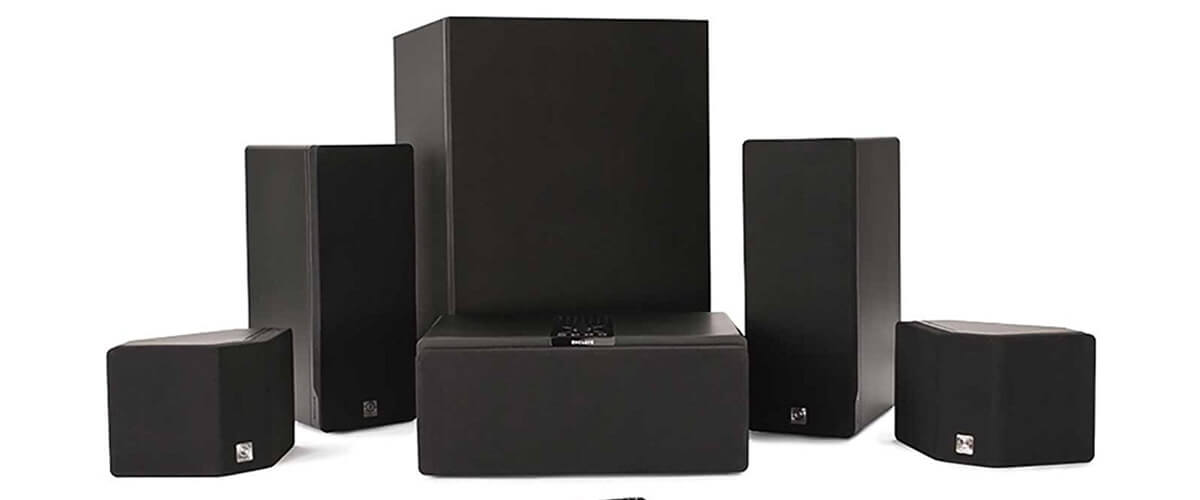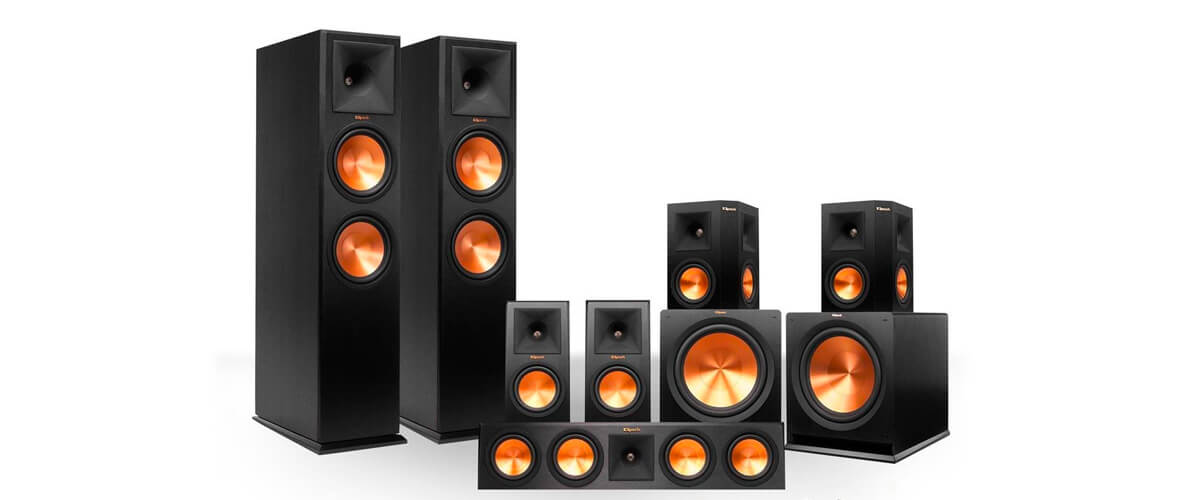The Ultimate Guide to Buying the Best Wireless Home Theater System or Wireless Surround Sound System
Want that theater experience in your own home? Don’t want to tear down walls or trip over cords to make it happen? Then you’re in the right place. Other publications may tell you that real wireless speaker systems don’t exist. In 2025 that’s far from the truth. Our guide to the best wireless surround sound system will shave hours off your search.
We’ll get you informed on the latest technology and then help you pick the perfect product. With no cords to manage and no hassle during setup, the best wireless home theater system is a few clicks away! You can read from start to finish, or click below to jump to any point in this guide.
Learn about wireless home theater systems:
- WiFi Surround Sound Systems Explained
- The Best Wireless Surround Sound Speakers: WiSA Wireless for a New Era
- Wireless Home Theater System Components Explained
Buy wireless home theater systems:
Wireless Home Theater System Technology Explained
Confused about the best wireless home theater system technology? Don’t feel bad. Many companies try to confuse customers with acronyms. Bluetooth, WiFi, and WiSA will all come up in your search. But only one of these technologies offers a true wireless home theater experience. We’ll take you through a step-by-step analysis of components, speaker style, and that whole 7.1 vs 5.1 thing.
Bluetooth Surround Sound: Myth!
Did you get to this guide by searching for Bluetooth surround sound systems? You aren’t alone. Most people don’t realize that surround sound and Bluetooth are not compatible. There are a few practical limitations that make Bluetooth unsuitable for true 5.1, 7.1, or 7.2 surround sound. Technologies like Dolby Atmos and THX further complicate matters for Bluetooth.
Limitations of Bluetooth Surround Sound Systems
Bluetooth is a helpful technology. It’s built into almost all modern phones, cars, and headphones. But the limitations of Bluetooth prevent it from being useful for home theaters. Here’s a few key reasons why:
Bluetooth wireless can’t stream enough channels for wireless surround sound systems. You may be familiar with Bluetooth technology in wireless speakers and wireless headphones. But we bet you’ve never seen a Bluetooth surround sound system! It’s a safe bet, because they don’t exist.
Bluetooth is a technology designed for mobile devices. That means it can only stream two channels of sound: One for left and one for right. True wireless surround sound requires up to seven channels. That’s far beyond the capabilities of Bluetooth!
This is where things can get confusing. You’ll find Bluetooth-enabled surround sound receivers are common. They often appear as you search for Bluetooth surround sound. These products accept Bluetooth as an input. The actual surround sound speakers will still need wiring. In this case, you’re able to use any old surround sound system, and that’s not why you’re reading this guide now is it?
Bluetooth can’t go the distance. The best wireless surround systems should be 10-20 feet away from the smart TV or projector. There is usually furniture and other obstacles in the way. While most Bluetooth products offer a rating for use up to 30 feet away, it’s not practical.
Try to use your wireless Bluetooth headphones at a 30-foot distance to see what we mean. Are you experiencing degraded sound quality, interference, and total failure to work? Bluetooth chips use limited power, which makes them great for small devices. That same benefit isn’t so great when we’re talking about a best wireless home theater system.
There are a lot of Bluetooth devices floating around. If you spend the money on the best wireless home theater system then you want the best sound too. That means a clean connection to provide clear, crisp, and uninterrupted sound.
Each speaker in a surround sound system handles specific frequencies. For example, wireless rear speakers handle background music and sound effects. They exist to enhance the primary audio experience. Wireless rear speaker sound is subtle, and needs a clear connection to work. Signal noise and distance will prevent Bluetooth wireless rear speakers from being effective.
Bluetooth Surround Sound Receivers with Older, Wired Systems
Do you own an older surround sound system and need a Bluetooth input? A Bluetooth transmitter is your best bet. This guide covers completely wireless home theater systems that rely on WiSA. WiSa is a different wireless technology altogether. More on this later…
WiFi Surround Sound Systems: Not Up to the Task
Is standard WiFi in your consideration set? Think again! Tried and true WiFi works well for any device that needs to go on the internet, but what about speakers? There are plenty of name brand single speaker options that work through WiFi. Google Home, Amazon Alexa, and Sonos come to mind. But those aren’t useful for home theater setups, and don’t offer surround sound. So what’s the deal? Why won’t these name brand companies offer a more comprehensive 5.1 or 7.1 WiFi solution?
WiFi signals are too crowded for true surround sound. Newer bargain home theater systems feature one or more components listed as wireless. This means they use regular WiFi like your laptop or tablet.
The thing about WiFi is, well, everyone in the house is using it. WiFi routers aren’t designed to handle surround sound traffic. Surround sound movies or shows need a lot of clear air to work well. You may be able to get away with a WiFi subwoofer without noticing, but other speaker channels suffer. That’s why there are no wireless 5.1 or 7.1 home theater systems that rely on WiFi.
The Best Wireless Surround Sound Speakers: WiSA Wireless for a New Era
Welcome to the future! In 2018 we have self driving cars, free same day delivery on anything, and soy substitutes for daily meals. And thanks to the Wireless Speaker and Audio Association we have WiSA.
What Exactly is WiSA?
Chances are you’ve never even heard of WiSA. The WiSA standard is for the best wireless home theater system. Brands license the technology to use in various components. WiSA gets bandwidth-heavy home theater systems off the cord. Think of WiSA as WiFi on steroids.
WiSA is the only way to achieve a true wireless surround sound setup. There are a few benefits to this unique and patented technology for home theater systems.
WiSA offers simple setup and installation. Imagine unpacking and using your new home theater system in under 15 minutes. WiSA offers that! It’s one of the main reasons WiSA is the best wireless surround sound system.
WiSA has better audio quality than many wired surround sound systems. It’s a bold claim, but happens to be true. WiSA’s powerful signal operates on a unique frequency other devices do not use. Listeners hear crystal clear audio from all channels with no interference. Dare we say that makes it better than many wired solutions.
WiSA synchronizes with the picture and has no latency. Other wireless technologies are laggy. Lag is most noticeable when people are speaking on the TV or projector. The mouth moving and voice audio will have a small but perceptible delay. We’re talking a few hundred milliseconds or more, which is enough to ruin the experience. That’s one of the main reasons Bluetooth and WiFi aren’t usable for a wireless home theater system.
WiSA offers near zero latency. There will be no discernible lag between what you are seeing and what you are hearing. WiSA is the only wireless technology that can offer latency at near zero levels.
WiSA systems are scalable. Need to add wireless speakers to complete your surround sound system? No problem. WiSA systems understand each module currently attached, and can scale to add more. You can buy a 5.1 surround WiSA system to fit your apartment space today. When you’re living out in the burbs and have a full den, add more speakers to make a 7.1 surround system.
WiSA isn’t all upside. It’s a new technology. And in the tech world new is code for expensive. Expect to pay a bit more for WiSA surround sound systems.
Wireless Home Theater System Components Explained
The best wireless surround sound system should have WiSA. Now let’s talk components. Like pieces of a puzzle components are a common area of confusion for home theater buyers. Let’s examine each piece and demystify your options.
7.1 Surround Sound vs 5.1 Surround Sound
What’s included in 5.1 and 7.1 surround sound systems

Diagram of a full 7.1 wireless home theatre system
The WiSA wireless receiver is the heart of the surround sound system. A powerful transmitter sends audio to each wireless speaker in the system. The receiver also acts as a hub to plug in wired devices like an Amazon Fire TV Cube or Google Chromecast. The receiver may be standalone, or built into the center wireless speaker.
1. A center wireless speaker transmits the main event. That means it is usually the loudest speaker in the surround sound setup. You’ll be hearing most of the action through this speaker. That includes dialogue and big sound effects that take center stage.
A quick word on sound bars. Wireless sound bars are a popular method of achieving center channel sound. Most speakers in modern flat TVs are small and don’t deliver very much power. A wireless sound bar is not enough to get the surround sound effect. In fact, it may actually make it harder to hear certain parts of a movie or television show. A common audiophile complaint
2. Front left and right wireless speakers. These speakers sit at an angle to the viewer and to the left and right of the TV or projector screen. They add weight to the center sound channel depending on where it is coming from on screen. This is the first step in a wireless home theater system.
3. Back left and right wireless speakers. These smaller speakers complete a standard 5-speaker surround sound setup. They broadcast off screen voices, sound effects, and ambient noise. Back channel speakers sit behind the viewer and angle inward. Sounds from back or rear wireless speakers can be subtle. That said, they are critical to any best wireless surround sound system.
4. Side left and right wireless speakers. Side channel speakers complete a 7-speaker setup. They provide a middle range between front and back. Trust me, you’ll never want to go back after experiencing a full 7.1 surround sound setup for the first time. You feel like you are in the action and the center of the entire movie or TV show. Side channel speakers are a bit louder than back speakers for a rolling sound experience.
5. A WiSA wireless subwoofer is the .1 on 5.1 and 7.1 surround sound systems. Bass is all about vibration during dramatic music, explosions, and other similar effects. A wireless subwoofer delivers the deep, rumbling sounds you crave. Never leave this critical component out! Fear not! Our contenders for best wireless home theater systems feature a prominent wireless subwoofer.
Demystifying Dolby Atmos 7.2 surround sound. Have you seen any of the latest movies in theaters? Then you may have experienced this new sound technology already. Dolby Atmos 7.2 surround – sometimes noted as 7.1.2 – adds two ceiling speakers to the standard 7.1 surround sound setup. This enables another dimension of immersive sound. The tech is making it’s way into the home, so be on the lookout for WiSA enabled wireless 7.2 surround sound speakers.
Understand what goes into the best wireless home theater system? Then let’s take a look at the lineup!
The Best Home Theater System with Wireless Speakers
If you made it here, chances are you are ready to buy a new WiSA surround sound system for your home theater. Grab that credit card, because it’s about to get real. Though WiSA is a new technology, there are quite a few manufacturers with offerings. We’re going to highlight the best of the bunch based on real world usage and our own expert knowledge about home audio pros and cons.
The Best Wireless Home Theater Systems Out of the Box for 2025
Our first category covers the WiSA home theater products at the intersection of quality, value, and ease of use. These technologies are new, and that always brings challenges when it comes to setup and usability.
Enclave Audio CineHome HD 5.1 Wireless Audio Home Theater System
Enclave has created a home theater system ticks all the boxes. It’s easy to set up, assembling in about 15 minutes. Best of all, the CineHome produces rich, well-balanced audio at a fraction of the price of similar sounding WiSA systems. That makes it a big value, and the top of our list.
Enclave Audio CineHome HD at Amazon.com
![]()
Best price to sound quality in WiSA systems hands down. You’ll feel in the middle of the action without the gaping hole in your wallet.
![]()
Simple setup that just works. You’ll likely spend most of your setup time adjusting the rear speakers for your room to achieve optimal sound balance. Other than that the CineHome HD is plug and play.
![]() Rear speakers require power outlets. This should be obvious, but all speakers require power. If you don’t have nearby outlets where the rear speakers need to live, you may find that you have another cord situation to manage.
Rear speakers require power outlets. This should be obvious, but all speakers require power. If you don’t have nearby outlets where the rear speakers need to live, you may find that you have another cord situation to manage.
Klipsch 7.2 RP-260 Reference Premiere Surround Sound Speaker Package 
Klipsch is known for a distinct design aesthetic and a focus on sound. And the same brand characteristics that make Klipsch loyalists rejoice are found in the Reference Premiere wireless speaker series.
Klipsch 7.2 RP-260 Reference Premiere Surround Sound Speaker Package at Amazon.com
![]()
Outstanding 7.1 surround sound. The Reference Premiere creates a dimensional, rich, and totally satisfying 7.1 experience. You won’t find better WiSA sound quality under this price point.
![]() Steeply priced. Klipsch has never been a bargain brand, but we feel like they are gouging with WiSA technology. Coming in at over twice the cost of similar wired speakers from the same lineup, one would think more features have been added. Unfortunately that’s not the case, and what you get is a very comparable system at a much higher price point.
Steeply priced. Klipsch has never been a bargain brand, but we feel like they are gouging with WiSA technology. Coming in at over twice the cost of similar wired speakers from the same lineup, one would think more features have been added. Unfortunately that’s not the case, and what you get is a very comparable system at a much higher price point.
![]() Setup is not intuitive. There’s something about wireless technology that implies simplicity. But setting up a Reference Premiere system is a bespoke job. There’s an expert setup option available for a reason, and unless you are a true audiophile you may want to take it.
Setup is not intuitive. There’s something about wireless technology that implies simplicity. But setting up a Reference Premiere system is a bespoke job. There’s an expert setup option available for a reason, and unless you are a true audiophile you may want to take it.
Axiim Q Wireless Home Theater System $4,999.99
Relatively unknown brand Axiim is making the jump into WiSA in a big way. Their modular system offers flexibility to scale based on room size and need, and offers the most up to date technology package under a single brand. That convenience also comes at a cost.

Axiim Q Wireless Home Theater System $4,999.9 at Axiim.com
![]()
The most complete WiSA system. Axiim built the Q series to be modular and intuitive. That engineering allows you to purchase a smaller system and add more components later, or scale based on need, features we have seen in other systems touted as the best Bluetooth speakers.
![]() Most expensive in our list. The Q series is a wonderful system, but you pay for the pleasure. Coming in at well above even Klipsch, Axiim is shooting for the high end market in every way. If you can afford to buy, you may find the ease of setup and modularity well worth the price.
Most expensive in our list. The Q series is a wonderful system, but you pay for the pleasure. Coming in at well above even Klipsch, Axiim is shooting for the high end market in every way. If you can afford to buy, you may find the ease of setup and modularity well worth the price.
![]() The look needs work. Axiim may be great at making wireless surround sound speakers, but they may want to take some design lessons from other brands. The Q series is bland and expected at best, somewhat of an eyesore at worst. Perhaps future products from the brand will kill the 90’s look in favor of something sleeker.
The look needs work. Axiim may be great at making wireless surround sound speakers, but they may want to take some design lessons from other brands. The Q series is bland and expected at best, somewhat of an eyesore at worst. Perhaps future products from the brand will kill the 90’s look in favor of something sleeker.
Conclusion: WiSA Wireless Home Theater Systems Are Ready
While there are new WiSA products in the works, the current lineup offers high-performing packages at both ends of the price spectrum. The technology works as promised, saving you the hassle of cords without sacrificing sound quality in the least. We expect to see this market continue to grow and mature with more WiSA offerings from mainstream manufacturers like JBL, Polk, Bose, and more.